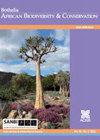Coordinating invasive alien species management in a biodiversity hotspot: The CAPE Invasive Alien Animals Working Group
IF 0.5
4区 生物学
Q4 PLANT SCIENCES
引用次数: 3
Abstract
Background: The effectiveness of invasive alien species management in South Africa, and elsewhere, can be mproved by ensuring there are strong links and feedbacks between science and management. The CAPE Invasive Alien Animals Working Group (CAPE IAAWG) was established in 2008 to enhance cooperation among stakeholders such as implementing agencies and researchers, and thereby improve the management of invasive animals in the Greater Cape Floristic Region.Objectives: In this article we highlight where and how the working group has advanced our understanding of research and the implementation of management objectives and consider the working group’s successes and failures.Methods: We analyse the attendance of meetings by different stakeholders and the frequency of discussion topics on meeting agendas throughout the sequence of meetings from 2008 to 2019. We document insights based on published accounts or the experiences of the authors from eight different management projects.Results: Meetings are attended by stakeholders from NGOs, universities, and local, provincial and national government agencies as well as private individuals. Topics of discussion ranged from details of specific alien animal invasions (e.g. the House Crow in Cape Town), to considering the risks posed by broad groups (e.g. earthworms), to specific management techniques (e.g. guidelines for trapping invasive alien birds). Through the eight projects described here the CAPE IAAWG has: (i) contributed to capacity building through funding and advising on post-graduate research projects; (ii) provided ad hoc support to staff of agencies that implement invasive alien animal control; (iii) acted as a focal point for a community of practice that is supportive of decision making and policy development; and (iv) played a vital role in linking research, management and policy in a manner accessible to a broader range of stakeholders. The projects undertaken by the group reveal several lessons for managing invasive animals: (i) the importance of logistics and contract efficiency, (ii) the need for effective stakeholder engagement by the project team, (iii) the need to effectively address conflicts between role players, and (iv) the importance of including ethical and animal rights considerations in the decision making processes.Conclusion: The CAPE IAAWG has been a valuable forum to improve management effectiveness and support implementation decisions. Due to its small cost and time footprint, the working group has remained viable and retained a core of committed members, ensuring ongoing institutional buy-in. The working group will remain successful so long as the group is supported by its members and their organisations.在生物多样性热点地区协调外来入侵物种管理:CAPE外来入侵动物工作组
背景:通过确保科学与管理之间的紧密联系和反馈,可以提高南非和其他地方外来入侵物种管理的有效性。CAPE外来入侵动物工作组(CAPE IAAWG)成立于2008年,旨在加强实施机构和研究人员等利益相关者之间的合作,从而改善大开普植物区入侵动物的管理。目标:在本文中,我们强调了工作组在哪里以及如何提高了我们对研究和管理目标实施的理解,并考虑了工作组的成功和失败。方法:我们分析了2008年至2019年整个会议序列中不同利益相关者的会议出席率和会议议程讨论主题的频率。我们根据8个不同管理项目的作者发表的文章或经验来记录见解。结果:来自非政府组织、大学、地方、省和国家政府机构以及个人的利益相关者参加了会议。讨论的主题从特定外来动物入侵的细节(例如开普敦的家鸦),到考虑广泛群体(例如蚯蚓)构成的风险,再到具体的管理技术(例如捕获入侵外来鸟类的指南)。通过上述八个项目,CAPE IAAWG:(i)通过资助研究生研究项目并为其提供咨询意见,促进了能力建设;(ii)向实施外来入侵动物控制的机构的工作人员提供特别支助;(iii)作为支持决策和政策制定的实践社区的联络点;(iv)在以更广泛的利益攸关方可获得的方式将研究、管理和政策联系起来方面发挥了至关重要的作用。该小组开展的项目揭示了管理入侵动物的几个经验教训:(i)物流和合同效率的重要性,(ii)项目团队有效参与利益相关者的必要性,(iii)有效解决角色参与者之间冲突的必要性,以及(iv)在决策过程中考虑道德和动物权利因素的重要性。结论:CAPE IAAWG已成为提高管理有效性和支持实施决策的重要论坛。由于其成本和时间占用较小,工作组仍然可行,并保留了一批忠诚的核心成员,确保了机构的持续支持。只要工作组得到其成员及其组织的支持,工作组就会保持成功。
本文章由计算机程序翻译,如有差异,请以英文原文为准。
求助全文
约1分钟内获得全文
求助全文
来源期刊

Bothalia
生物-植物科学
CiteScore
1.70
自引率
0.00%
发文量
12
期刊介绍:
Bothalia: African Biodiversity & Conservation is published by AOSIS for the South African National Biodiversity Institute (SANBI) and aims to disseminate knowledge, information and innovative approaches that promote and enhance the wise use and management of biodiversity in order to sustain the systems and species that support and benefit the people of Africa.
The journal was previously published as Bothalia, and had served the South African botanical community since 1921. However the expanded mandate of SANBI necessitated a broader scope for the journal, and in 2014, the subtitle, African Biodiversity & Conservation was added to reflect this change.
 求助内容:
求助内容: 应助结果提醒方式:
应助结果提醒方式:


